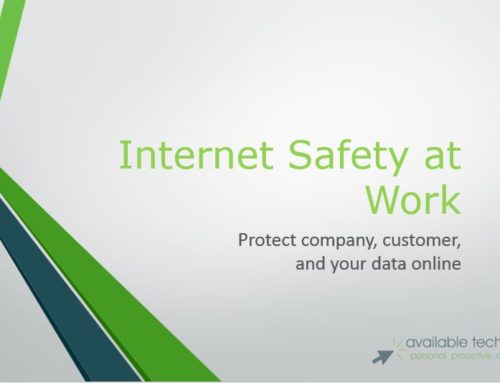Virus 101 -or- Malware for Beginners
——————————————————————–
Being a computer technician isn’t an entirely thankless job. Every one of us with a job to do, including garbagemen and politicians, occasionally experience intense moments of satisfaction from the faithful performance of our daily grind. That’s why we keep on doing what we do.
But IT Guys (yours truly excluded) have, as time passes, developed fragile egos from the constant flip-flop from hero to scapegoat 10 times per day. In the morning it’s “Hey, the computer guy’s here!” and in the afternoon it’s “Everything worked until YOU showed up!??”
But it’s those brief realizations of childish fulfillment that keep us going. I am having a great day if someone chooses to call me a “genius” or “guru”, which I quickly downplay by insisting that I am merely “digitally dominant.” And yes, at the end of those kinds of days, we IT folks feel a bit like brightly-costumed defenders of the innocent with the theatrical stage-wind throwing our fluttering capes out behind us. We then stand tall and proud, and remark, “All in a day’s work, Mrs. Jones, all in a day’s work.”
According to the SuperHero Name Generator, my super hero name is “The Elastic Sapphire Locomotive”, a moniker that I hope I can live up to. This isn’t easy, because all heroes of Super proportions have dark and dangerous enemies that stay up late at night coming up with new ways to expel us from our Industry Certified thrones.
Similar to comic book super heroes, computer guys and gals have not only normal, boring, annoying enemies (like Green Goblin, Sandman, the Phantom, and Penguin) but also that one foe that predictably keeps popping up, knows your weaknesses, and is always defeated, but never destroyed – our “Arch-Nemesis.” For computer techs, our arch-nemesis is the computer virus.
Comic book villains come in 2 varieties, not unlike politicians. The first type works toward the ultimate goal of attaining power while advancing chaos and destroying order. The second type commits crime strictly for monetary gain. Ironically, computer viruses fall into the same 2 categories.
This month, I’ll present the important info about viruses that you need to know, in a format that should be easy to comprehend even for the avid “Dick and Jane” reader.
———————————————————————
Types of Viruses
When your computer starts throwing up error messages, blue screens or just starts acting plain-old “weird”, most people say “Must be a virus!” But do you really know the difference between a virus, a trojan, a worm or any of 10 other kinds of malicious software waiting to attack your poor innocent computer? Well, read on, and in the next 10 minutes, you will!
Most people use the terms virus, worm, and trojan as synonyms, but these terms are not the same. They all can do damage, but in different ways. And just like Spiderman always says, “Knowing your enemy is the only way to defeat him.”
– A computer virus attaches itself to a program or file so it can spread from one computer to another, leaving infections as it travels. Much like human viruses, computer viruses can range in severity: Some viruses cause only mildly annoying effects while others can damage your hardware, software or files. Almost all viruses are attached to an executable file, which means the virus may exist on your computer but it cannot infect your computer unless you run or open the malicious program. It is important to note that a virus cannot be spread without a human action, (such as running an infected program) to keep it going. People continue the spread of a computer virus, mostly unknowingly, by sharing infecting files or sending e-mails with viruses as attachments in the e-mail.
– A worm is similar to a virus by its design, and is considered to be a sub-class of a virus. Worms spread from computer to computer, but unlike a virus, worms have the capability to travel without any help from a person. The biggest danger with a worm is its capability to replicate itself on your system, so rather than your computer sending out a single worm, it could send out hundreds or thousands of copies of itself, creating a huge devastating effect. For example, a worm can replicate and send itself out to everyone listed in your address book, and then to everyone in each of your contacts address books, and the manifest continues on down the line. Due to the copying nature of a worm and its capability to travel across networks the end result in most cases is that the worm consumes too much bandwidth, causing servers and individual computers to stop responding. Some worms are designed to allow a user to control your computer remotely without your knowledge or permission. This is scary stuff!
– A Trojan Horse (or Trojan) is a malicious program (Malware) that looks like something helpful but is actually out to destroy your computer. Trojans can look like coupon printing programs, music downloading software, free games or even antivirus programs, like the infamous “fakealert” trojans. Some are just annoying, doing things like changing your background or redirecting your web browser to a random search site or site with (ahem) objectionable content. Others can cause serious damage by deleting files and destroying information on your system.
A type of Trojan known as a “backdoor” trojan creates a backdoor on your computer that gives malicious users access to your system, possibly allowing confidential or personal information to be compromised. Unlike viruses and worms, Trojans do not reproduce by infecting other files nor do they self-replicate.
A subset of these 3 types of malicious software is called a blended threat. A blended threat is an attack that combines characteristics of 2 or more of the 3 types of ifections to produce a hybrid attack that can be especially hard to detect and remove. Many attacks that we remove on a daily basis fall into this category and require special tools to clean from your system.
————————————————————————–
Who Writes These Things?
The typical virus author is male, from 14 to 24 years old. He has an intermediate knowledge of programming, since most viruses are remarkably easy to write. You can think of the guys who write malicious code as vandals, who are either trying to make money or show off to their friends. In some subcultures, whoever does the most damage gets the most credibility.
These days, though, most of the viruses are written to cause just enough trouble get you to put in a credit card number in order to make the problems go away. This is electronic extortion, and is a worldwide epidemic.
Where do these people live? According to Symantec research nearly 46 percent of all malicious attacks come from China. London comes in second place at 14.8 percent. 13% or so originate from the US.
—————————————————————————-
How do you stay clean?
Now that we know more about the threat, there are a few things that need your attention in order for your computer to stay clean and virus free.
Do your Windows Updates – Microsoft releases critical updates to plug holes that let viruses do their dirty work. Do your updates to stay secure. We reocommend doing only the critical updates, not the optional ones.
Click only on trusted sites – this can be tough to do, but with so many infections spreading through infected sites, if you can get by going to well known sites, rather than clicking on anything you find on Google, you will stay virus free longer.
Install an Antivirus and keep it updated
Use a firewall – a hardware router or a software firewall program, like ESET Smart Security will keep many intrusion attacks out, and will keep your computer from allowing malicious communication attempts to go out on the network if your computer gets infected
———————————————————————-
Upcoming Virus Trends:
What changes can we expect in the next year?
Internet users will continue to suffer increased attacks by virus writes who want you to download their malware. Look for increased attacks through social networking sites like facebook and twitter.
Also, as the popularity of Apple products continue to grow, Mac and iPhone users–two of the most popular products by Apple–should look to protect the content they place on their devices as more attackers will devote time to create malware to exploit these devices.
With the increased use of smartphones, mobile security will also be an area of concern.
“Scareware” or fake antivirus software are also expected to make a bigger presence next year. Computers may even be “hijacked” or rendered useless by cybercriminals, who control the machines until the owners pay a ransom fee.
————————————————————————–
Armed with an understanding of the dark nature of the forces that oppose you, go out and combat evil. With courage and fortitude you and your fearless computer companion can face and defeat any sinister digital foe.
You can even come up with your own cyber-superhero names and create an alternate identity for yourself. Choose a sidekick and start brainstorming. Here are some names to get you started:
GigaRanger and Bitboy
Mistress Vira and Technolad
The Immutable Technemesis
Digidefender and Virulad
Dr. Disinfector and the Human Viradicator
As for me, I am the “Elastic Sapphire Locomotive.” And in the words of Batman, “I chose this life. I know what I’m doing. And on any given day, I could stop doing it. Today, however isn’t that day. And tomorrow won’t be either.”
Mike Lane, Available Technology Inc
http://dmichaellane.com





